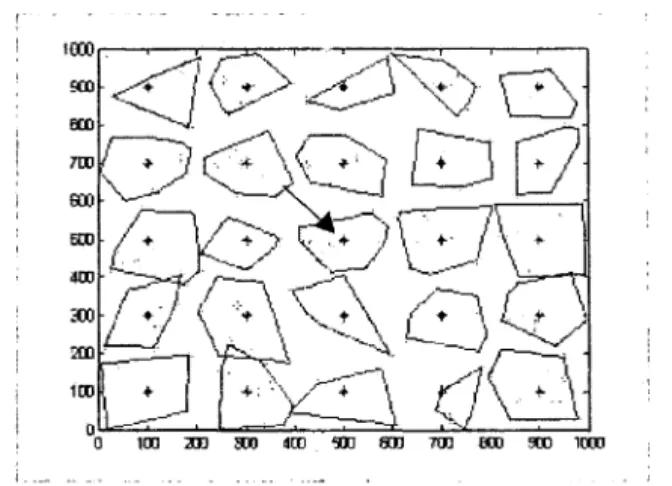HAL Id: hal-02127549
https://hal.archives-ouvertes.fr/hal-02127549
Submitted on 27 May 2019HAL is a multi-disciplinary open access archive for the deposit and dissemination of sci-entific research documents, whether they are pub-lished or not. The documents may come from teaching and research institutions in France or abroad, or from public or private research centers.
L’archive ouverte pluridisciplinaire HAL, est destinée au dépôt et à la diffusion de documents scientifiques de niveau recherche, publiés ou non, émanant des établissements d’enseignement et de recherche français ou étrangers, des laboratoires publics ou privés.
Access point association in IEEE 802.11 WLAN
Loutfi Nuaymi, Jinane El-Sayah
To cite this version:
Loutfi Nuaymi, Jinane El-Sayah. Access point association in IEEE 802.11 WLAN. ICCTA’04 : First International conference on Information and communication technologies : from theory to applications, April 19-23, Apr 2004, Damascus, Syria. pp.211 - 212, �10.1109/ICTTA.2004.1307698�. �hal-02127549�
Access Point Association in IEEE 802.11 WLAN
Loutfi Nuaymi - Jinane El-Sayah ENST Bretagne
2, Rue de la Chataigneraie, B.P. 78, Cesson Sévigné 35512 Cedex, FRANCE e-mail: loutfi.nuaymi(Wenst-bretagne .fr ; j inanesayah@hotmail.com
Keywords-WLAN, IEEE 802.11, selection, association, access points
Subject- Here is an extended abstract of the work we would like to present at ICTT A'04 (April 04)
I. Introduction- ln fEEE 802. l l [ 1] Wireless Local Area Networks (WLAN), each wireless station (STA) is associated to one and only one AP (Access Point). The selection of the AP for every wireless stations is an important procedure. A proper choice incrcases the total capacity of 802.11 WLAN and then leads to efficient use of the available frequency bandwidth. A bad cell selection can cause wireless networks blockings that could be avoided ([3]) as we show it in this paper.
Il. Access Point association in WLAN- The two modes of operation defined in the 802.11 standard are described: the Infrastructure and the Ad-Hoc modes, where there is no access points. In this paper, we consider only the infrastructure mode. The procedures that a ST A should perfonn in order to associate with an AP such as scanning, authentication ([ 5]) and association itself are reminded.
Two scanning procedures are defined: active and pa.<:sive scanning. A STA, after scaiming and mak:ing a list of al! available APs in the network, will choose an AP to associate with. Which critcrion must the STA use to select this AP? This criterion is not specifically slated in 802.11 standard. DifTerent possible method of selection are applied in manufacturcrs' dcviccs. In most prcscntly-proposcd 802.11 products, the STA chooses to associa.te with the AP that has the best pe1formanccs in the tcrm of Signal to Noise Ratio (SNR) at the ST A geographical position.
We highlight the inconvenients of the cmrently-used methods of selection of the access points by the wireless stations and try to find and to propose solutions that can rectify this situation.
III. Model and results- We simula.te a simple WLAN model for differcnt critcrias of AP selection: received power lev el, receivcd signal-to-intereference ratio and AP-ST A
distance. Channels are a'>sîgned to APs according to 802.11 standard. We remînd in the paper APs channel assignment mies.
To calculate the Signal to Noise Ratio (SNR) betwecn each station and cach access point, we consider that Noise = sum of the transmitted power of each AP using the same channel * link gain between this AP and the wireless station.
In the paper, simulation results are commented. For example, Figure 2 shows the AP cclls (callcd Basic Service Arca or BSA) for a non-uniform distribution of wireless stations, where the best SNR criterion is used. W e see that this type of AP selection leads to a cell that bas a high concentration of stations. In fact, cells shapes are indendent of the concentration of wireless stations. A WLAN cell with a high number of stations might have quickly bad perfonnances: low data rate and high delays. In the
paper we propose some solutions such as transmitted power decrease for the AP that bas a high data load.
Fig. 2- For a non-uniform distribution of wireless stations, shape ofWLAN cells for an AP selection based on the best received SNR. The central cell bas a high number of stations. This leads to bad performances.
IV. Conclusion
In this paper, we highlight the fact that if the load distribution isn't con;;idered for AP selection in a WLAN, this may lead to inefficient use of the bandwidth.
Sorne solutions that can rectify this situation are proposed and discussed at the end of the article: power variations and proposing and implementing load distribution algorithms in the 802.11 standard are enhancements that can lead to a gn:ater capacity and better perfo1mances. Research papers proposing solutions are mentioned (e.g., [7])
References (used in this abstract)
[ 1] IEEE Std 802.11-1999, Part 11: Wireless LAN Medium Access Control (MAC) and Physical Layer (PHY) specifications, 1999
[3] Glènn Judd and Peter Steenkiste. «Fixing 802.11 Access Point Sclection». ACM SIGCOMM Computer Communications Review. Volume 32, Number: 3, July 2002.
[5] J. Walker, "Unsafe at any key size: An analysis of the WEP encapsulation", Tech Rep. 03628E, IEEE 802.11 committee, March 2000.
[7] Lan Wang, Zhisheng Niu, Yanfeng Zhu, Hui Deng, Masashi Yano. "Integration of SNR, Load and Time in Handoff. Initiation for Wireless LAN". IEEE PIMRC conference, Sept 2003.
